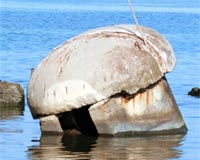| . |  |
. |
West Lafayette IN (SPX) Feb 08, 2010 Understanding local human cultures is key to preserving gorillas, elephants and other wildlife in African parks and reserves, according to new research from Purdue University. "Conservation efforts and the management of protected areas are often designed with the best intentions, but sometimes supporting scientific data is missing or incorrect assumptions are made about a local culture or even the outsiders or trade that plays a role in the area," said Melissa Remis, a professor of anthropology who studies gorillas. "Conservation isn't just about protecting wildlife, you also need to consider the human dimension such as how local hunting technologies or even migration can change how land is used." Remis, a biological anthropologist, and Rebecca Hardin, an associate professor of cultural anthropology at the University of Michigan's School of Natural Resources, focused on issues specific to animal species, forest fragmentation, ecotourism, local culture and industry in the Dzanga-Sangha Dense Forest Reserve in the Central African Republic. The forest is known for western lowland gorillas and a clearing that attracts up to 100 elephants at a time. The reserve is a multi-use zone that was created in 1991 and includes areas designated for research, tourism, local hunting, safari hunting and logging. Bayanga is the local town with a population of 5,000. Local communities may see wildlife, such as elephants, as a problem if they damage their crops. Other groups may resent saving local wildlife when they are struggling to feed their families and could use the protected species as a food source. These attitudes also can vary between ethnic groups, such as the local BaAka who have lived with the gorillas and elephants for years and the migrants who have more recently moved to the area because of jobs in logging or conservation. "Better integration of basic research in the ecological and social domains would really improve conservation strategies and outcomes, but it also would improve goodwill for the communities that often feel resentment toward protecting wildlife," Remis said. For example, researchers found that selective logging opens light gaps in the forest that result in new herbaceous vegetation growth. This food source helps sustain the local antelope, which are called duikers. These antelope, whose populations are declining, are the primary food source for most people in the area, and some local residents have been hunting gorillas as a substitute as for duiker. A stable duiker population would help take the hunting pressure off the protected species, Remis said. "This is an example where logging at certain low levels could actually help people sustain higher yields for hunting," she said. "Again, this is where science would help with land management." Remis and Hardin have studied the cultures and the animals, specifically elephants and gorillas, in this area since the 1990s. In addition to regular animal censuses, the researchers interviewed park guards, tourists, local residents and others. Findings from this research, which includes data up to 2005, appeared in last month's Conservation Biology. The research team also is evaluating additional data from 2005 to 2008. These recent animal censuses show that the local gorilla and elephant populations are declining even in the heart of the protected area. "This research reinforces the value of biological and cultural anthropologists working together," Remis said. "We devised a framework for transvaluation of wildlife species, which means the valuing of animals based on their ecological, economic and symbolic roles in human lives. Transvaluation provides insights that can be successfully integrated into more adaptive conservation policies. It demonstrates a way to marshal local and transnational support for conservation as it emphasizes that both local communities and international ones value these species for their magnificence, beyond their economic importance. These animals are the subject of local as well as international folktales and legends, and their extinction would have impacts in and beyond local communities. What would it be like for our children to grow up in a world without gorillas or elephants? "Through interviews with local residents and workers, we have a better understanding of how change, such as local economies and hunting technologies, affects conservation. This collaboration is helping us better understand how animals and humans are responding to each other." The Dzanga-Sangha Dense Forest Reserve was created in 1991 as an integrated conservation and development project by the Central African Republic government and World Wildlife Fund.
Share This Article With Planet Earth
Related Links Purdue University Darwin Today At TerraDaily.com
 Cold War Helped To Limit Species Invasions
Cold War Helped To Limit Species InvasionsHelsinki, Finland (SPX) Feb 04, 2010 A recent study about movement of bird species during the Cold War outlines one of the perils facing an expanding global economy - along with international trade comes the potential for a significant increase in invasive species that can disrupt ecosystems. The research found that during an extended period following World War II, when most trade and travel was interrupted between Eastern Eu ... read more |
|
| The content herein, unless otherwise known to be public domain, are Copyright 1995-2010 - SpaceDaily. AFP and UPI Wire Stories are copyright Agence France-Presse and United Press International. ESA Portal Reports are copyright European Space Agency. All NASA sourced material is public domain. Additional copyrights may apply in whole or part to other bona fide parties. Advertising does not imply endorsement,agreement or approval of any opinions, statements or information provided by SpaceDaily on any Web page published or hosted by SpaceDaily. Privacy Statement |